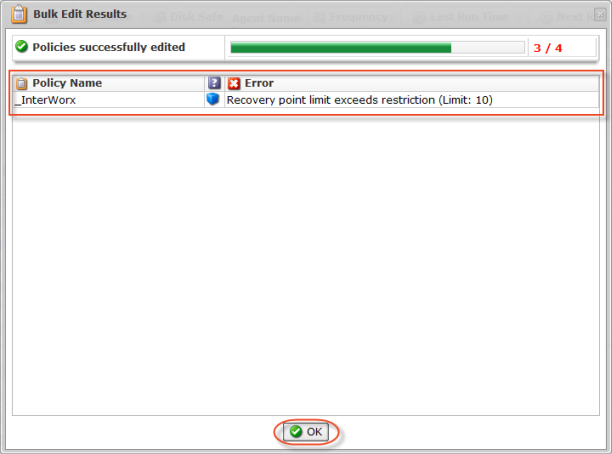| Tip You can see the date and time when a Policy was last edited in the "Last Edited On" column in the Policies list. |
Follow the instructions below to edit a Policy in Server Backup.
1. Click "Policy" in the Main Menu to access the "Policies" page.
2. Find the necessary Policy in the list of Policies and click on the "Edit" icon in the actions column for this Policy.
![]()
| Tip To find a Policy, you can use the Basic and Advanced List Filters. See Customize the Policies list. |
| Note You can also use the Bulk Edit function. See Bulk Editing below. |
3. The "Edit Policy" window will open.

The following tabs are available for editing:
"Policy Settings" Tab

This tab allows you to change the following settings:
- Name
- Description
- Server
- Disk Safe
- Replication Schedule
- Merge Schedule
The options are described in Create policies.
"Data Retention" Tab

This tab allows you to set the Retention rules and define the Archiving Schedule. These options are described in Define the archive schedule.
"File Excludes" Tab

This tab allows you to select the files you want to include or exclude from the Replication. These options are described in Exclude files and folders.
"Advanced Excludes" Tab

This tab allows you to define patterns according to which the files will be excluded from the Replication. These options are described in Exclude files and folders.
"SQL Server" Tab

This tab allows you to add Database Instances to the policy. These options are described in Add a MySQL instance to a policy.
"Exchange" Tab
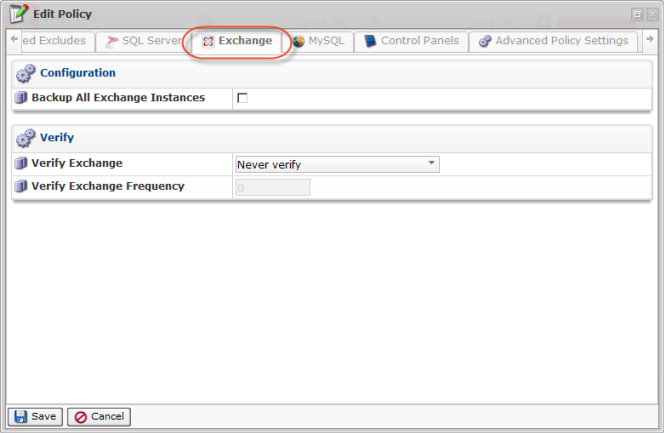
This tab allows you to configure an Exchange Instance for the Policy. These options are described in Configure an Exchange instance.
"MySQL" Tab

This tab allows you to add a MySQL Instance to the Policy. These options are described in Add a MySQL instance to a policy.
"Control Panels" Tab

This tab allows you to add a Hosting Control Panel Instance to the Policy. These options are described in Add control panel instance.
"Advanced Policy Settings" Tab

This tab allows you to change advanced Policy settings. These options are described in Create policies.
4. Click on "Save" at the bottom of the window to apply the changes.

5. The changed options will be shown in the Policies list.
Bulk Editing
Using the Bulk Editing option, you can edit multiple Policies at once. The same values will be set for all selected items. You can use Bulk Editing even if the Policies have different properties. Follow the instructions below to edit several Policies at once.
1. Select several Policies by selecting the checkboxes in the first column in the "Policies" list and clicking "Edit Selected."

2. The "Edit Policy" window opens.

The following parameters can be edited:
Scheduling
- Replication Schedule - This option allows you to set the Replication schedule. See Editing Replication Schedule below.
- Merge Schedule - This option allows you to set the merge schedule. See Editing Merge Schedule below.
- Disk Safe Verification Schedule - This option allows you to set the Disk Safe Verification schedule. See Schedule Disk Safe verification.
Recovery Point Retention
- Recovery Point Limit - Enter a value in this field to define the Recovery Points Limit according to the Volume's Maximum Allowed Archive Retention. When the number of created Recovery Points exceeds the limit, they will be merged. For more information, refer to Merge recovery points.
Archive Point Retention
- Archiving Schedule - This option allows you to set the archiving schedule.
Here you can select the following variants from the drop-down menu:- Add New Schedule - Creates a new archiving schedule. Several different schedules (e.g., hourly, daily, weekly) can be applied at the same time.
- Replace Existing Schedule - Replaces existing schedules with created ones.
- Remove All Schedules - Removes all schedules.

For more information about archiving schedules, refer to Define the archive schedule.
Advanced Policy Settings
- Force Full Block Scan - A Full Block Scan compares the MD5 sum of all allocated blocks to perform the backup and synchronize Server Backup. Enable this option to start a Full Block Scan each time the Replication is performed.
3. Click "Save" to apply the changes to all selected Policies at once.

4. If all Policies were edited successfully, the following window will appear:

| Note You may receive an error message if a Policy was not edited successfully. For example, if you entered the incorrect "Recovery Point Limit" value, the following window and message will appear. Eliminate all errors and repeat the procedure again.
|
5. The changed options will be shown in the Policies list.

Editing Replication Schedule
1. To start editing the "Replication Schedule," select the corresponding checkbox and click "Edit Schedule."

2. Select the Replication frequency from the drop-down menu.

The following options are available:
- On Demand
- Minutely
- Hourly
- Daily
- Weekly
- Monthly
- Yearly
You can find a detailed description of Replication frequencies here.
3. Specify the exact time of the Replication and click "OK."
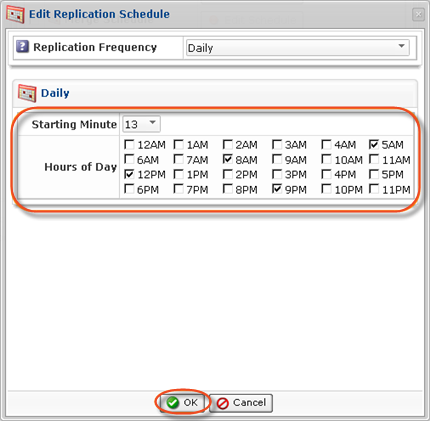
4. The schedule is defined (if the indicator turns green). Click "Save" to save the changes.

Editing Merge Schedule
1. To start editing the "Merge Schedule," select the corresponding checkbox and click "Edit Schedule."

2. Select the merge frequency from the drop-down menu.
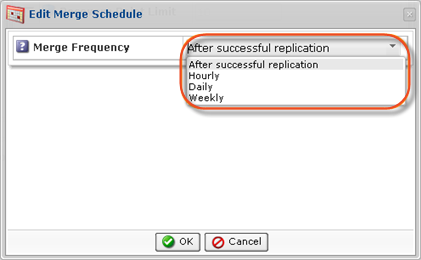
The following options are available:
- After successful replication
- Hourly
- Daily
- Weekly
You can find a detailed description of merge frequencies here.
3. Specify the exact time of the merge and click "OK."
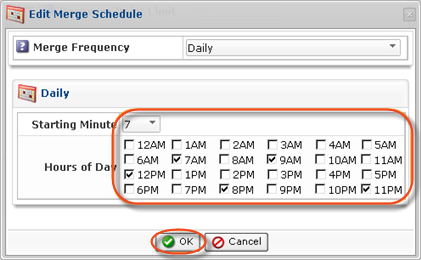
4. The schedule is defined (if the indicator turns green). Click "Save" to save the changes.

Editing Disk Safe Verification Schedule
1. To start editing the "Disk Safe Verification Schedule," select the corresponding checkbox and click "Edit Schedule."

2. Select the merge frequency from the drop-down menu.

The following options are available:
- On Demand
- Daily
- Weekly
- Monthly
You can find a detailed description of verification frequencies here.
3. Specify the exact time of the verification and click "OK."
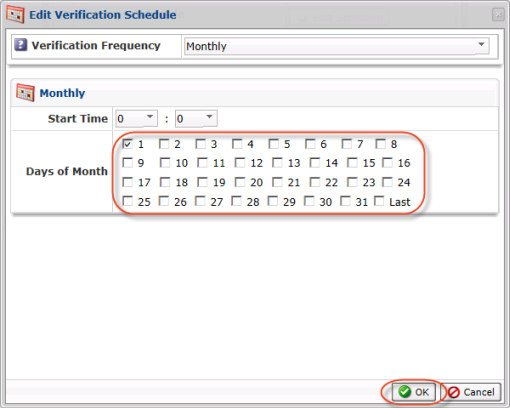
4. The schedule is defined (if the indicator turns green). Click "Save" to save the changes.

You can also edit Policies using the "Policies" tab of the Server "Details" Pane. This screen provides the same functionality as the main "Policies" screen. See more information in Access servers.

